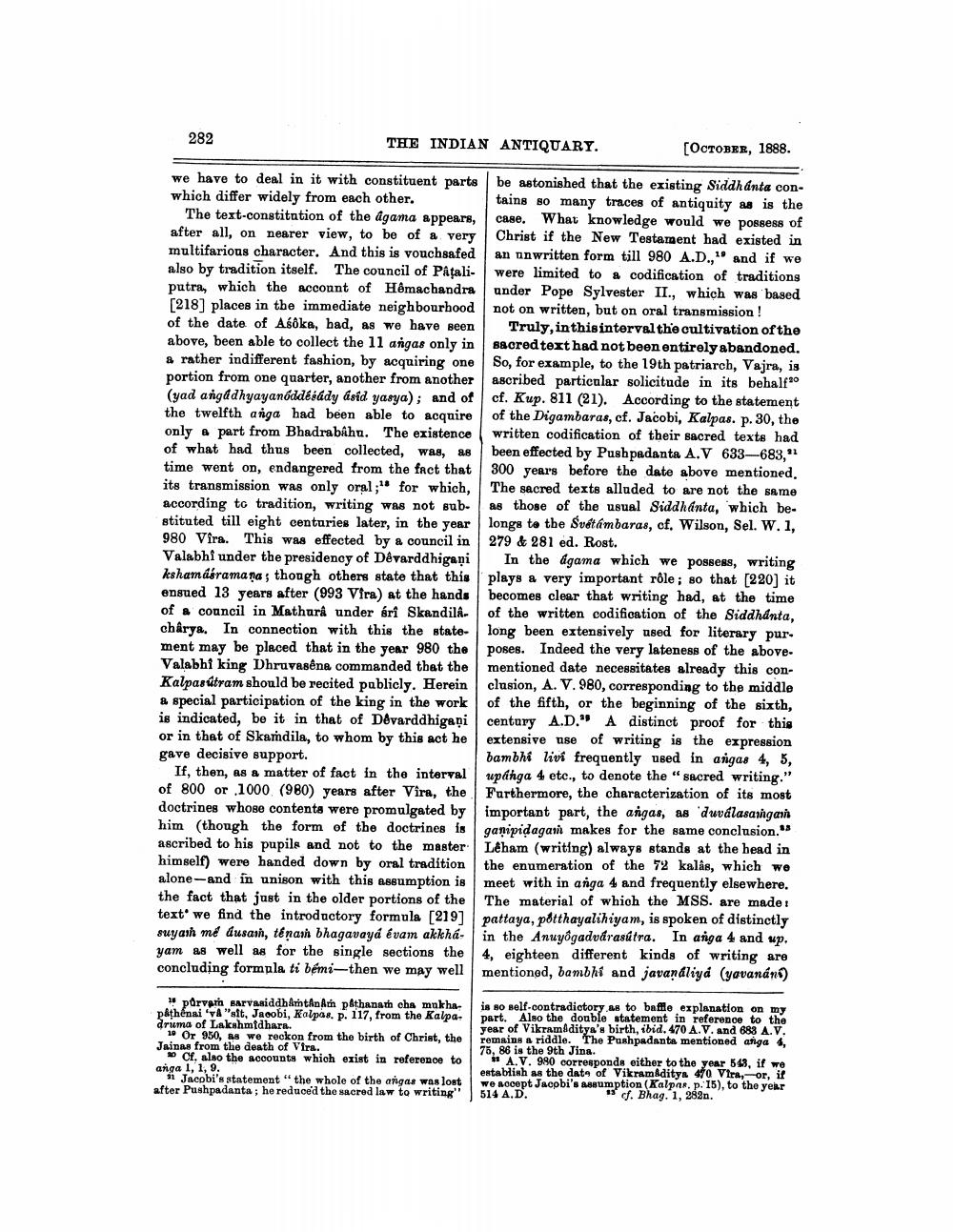________________
282
THE INDIAN ANTIQUARY.
[OCTOBER, 1888.
we have to deal in it with constituent parts be astonished that the existing Siddhanta conwhich differ widely from each other.
tains so many traces of antiquity as is the The text-constitution of the agama appears, case. What knowledge would we possess of after all, on nearer view, to be of a very Christ if the New Testament had existed in multifarious character. And this is vouchsafed an unwritten form till 980 A.D., and if we also by tradition itself. The council of Paali- were limited to & codification of traditions putra, which the account of Hêmachandra under Pope Sylvester II., which was based [218] places in the immediate neighbourhood not on written, but on oral transmission ! of the date of Asoka, had, as we have seen Truly, in this intervalthe cultivation of the above, been able to collect the 11 angas only in sacred text had not been entirely abandoned. & rather indifferent fashion, by acquiring one So, for example, to the 19th patriarch, Vajra, is portion from one quarter, another from another ascribed particular solicitude in its behalf (yad angadhyayan6ddésady asid yasya); and of cf. Kup. 811 (21). According to the statement the twelfth anga had been able to acquire of the Digambaras, cf. Jacobi, Kalpas. p. 30, the only a part from Bhadrabahu. The existence written codification of their sacred texts had of what had thus been collected, was, as been effected by Pushpadanta A.V 633–683," time went on, endangered from the fact that 300 years before the date above mentioned. its transmission was only oral;" for which, The sacred texts alluded to are not the same according to tradition, writing was not sub- as those of the usual Siddhanta, which bestituted till eight centuries later, in the year longs to the Svetambaras, cf. Wilson, Sel. W.1, 980 Vira. This was effected by a council in 279 & 281 ed. Rost. Valabhi under the presidency of Devarddhigani In the agama which we possess, writing ksham asramana, though others state that this plays a very important rôle ; so that [220] it ensued 13 years after (993 Vira) at the hands becomes clear that writing had, at the time of a council in Mathurâ under ári Skandila- of the written codification of the Siddhanta, charya. In connection with this the state- long been extensively used for literary pur. ment may be placed that in the year 980 the poses. Indeed the very lateness of the aboveValabhi king Dhruvasêna commanded that the mentioned date necessitates already this conKalpasútram should be recited pablicly. Hereinclusion, A. V.980, corresponding to the middle a special participation of the king in the work of the fifth, or the beginning of the sixth, is indicated, be it in that of Devarddhigaại century A.D." A distinct proof for this or in that of Skandila, to whom by this act he extensive use of writing is the expression gave decisive support.
bambhi livi frequently used in angas 4, 5, If, then, as a matter of fact in the interval uplinga 4 etc., to denote the sacred writing." of 800 or 1000 (980) years after Vira, the Furthermore, the characterization of its most doctrines whose contents were promulgated by important part, the angas, as 'dwdlasangan him (though the form of the doctrines is ganipidagar makes for the same conclusion." ascribed to his pupils and not to the master Lêham (writing) always stands at the head in himself) were handed down by oral tradition the enumeration of the 72 kalks, which we alone-and in unison with this assumption is meet with in anga 4 and frequently elsewhere. the fact that just in the older portions of the The material of which the MSS. are made text' we find the introductory formula [219] pattaya, pötthayalihiyam, is spoken of distinctly suyan mé dusan, tenan bhagavayé évam akkhá- in the Anuyôgadvarasútra. In anga 4 and up. yam as well as for the single sections the 4, eighteen different kinds of writing are concluding formula ti bémi-then we may well mentioned, bambhi and javanáliya (yavanáno)
porvarn sarvasiddh ArtAnAin pathana cha makhapathenai'ya ait, Jacobi, Kalpas. p. 117, from the Kalpa.
1. Or 950, as we reckon from the birth of Christ, the Jainas from the death of Vira.
Of, also the accounts which exist in reference to anga 1, 1, 9.
11 Jacobi's statement the whole of the argas was lost after Pushpadanta; he reduced the sacred law to writing"
is so self-contradictory as to baffle explanation on my year of Vikramiditya's birth, ibid. 470 A.V. and 688 A.V. remains a riddle. The Pushpadanta mentioned ariga 4. 75, 86 is the 9th Jina.
" A.V. 990 corresponds either to the year 543, if we establish as the data of Vikramaditya 470 Vira, or, if we accept Jacobi's maumption (Kalpas. p. 15), to the year 514 A.D.
* cf. Bhag. 1, 282n.




